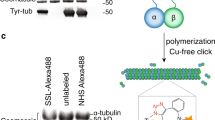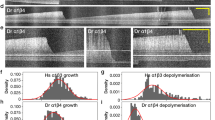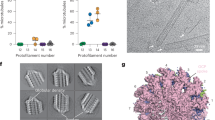Abstract
Microtubules are present in all eukaryotic cells and participate in a variety of cellular processes1. From recent studies it has become clear that nucleotides have a central role in the assembly of tubulin into microtubules2–5. The tubulin dimer binds two moles of guanine nucleotide: one (at the E-site) which can exchange with exogenous nucleotide and one (at the N-site) which does not exchange6. E-site GTP is hydrolysed during the assembly process4,7,8. Microtubule assembly can be induced by ATP through a contaminating nucleoside diphosphokinase activity that regenerates GTP following its hydrolysis—this is associated with tubulin polymerization4,9,10. Recent reports suggest that ATP has other effects on the assembly kinetics11–13, and we have shown14,15, using tubulin preparations lacking the nucleoside diphosphokinase activity, that ATP may play a critical part in the regulation of microtubule formation by binding to tubulin at a site which is distinct from the N- and E-sites. Kinetic data suggest a model in which ATP can act at the level of nucleation to stimulate assembly15. We now report the first direct evidence for the binding of ATP to tubulin and show that the corresponding dissociation constant is in a range of physiological significance.
This is a preview of subscription content, access via your institution
Access options
Subscribe to this journal
Receive 51 print issues and online access
$199.00 per year
only $3.90 per issue
Buy this article
- Purchase on Springer Link
- Instant access to full article PDF
Prices may be subject to local taxes which are calculated during checkout
Similar content being viewed by others
References
Roberts, K. & Hyams, J. S. (eds) Microtubules (Academic, New York, 1979).
Weisenberg, R. C. Science 177, 1104–1105 (1972).
Jacobs, M., Smith, H. & Taylor, E. W. J. molec. Biol 89, 455–468 (1974).
Penningroth, S. M. & Kirschner, M. W. J. molec. Biol. 115, 643–673 (1977).
Weisenberg, R. C., Derry, W. J. & Dickinson, P. J. Biochemistry 15, 4248–4254 (1976).
Weisenberg, R. C., Borisy, G. G. & Taylor, E. W. Biochemistry 7, 4466–4479 (1968).
Kobayashi, T. J. Biochem, Tokyo 77, 1193–1197 (1975).
David-Pfeury, T., Erickson, H. P. & Pantaloni, D. Proc. natn. Acad. Sci. U.S.A. 74, 5372–5376 (1977).
Jacobs, M. & Caplow, M. Biochem. biophys. Res. Commun. 68 (1976); Proc. natn. Acad. Sci. U.S.A. 74, 5372–5376 (1976).
Zeeberg, B. & Caplow, M. J. biol. Chem. 253, 1984–1990 (1978)
Selkoe, D. J. Brain Res. 172, 382–386 (1979).
Margolis, R. L. & Wilson, L. Cell 18, 673–679 (1979).
Kumagai, H., Nishida, E. & Sakai, H. J. Biochem, Tokyo 85, 495–502, 127–135 (1979).
Zabrecky, J. R. & Cole, R. D. J. biol Chem. 255, 11981–11985 (1980).
Zabrecky, J. R. & Cole, R. D. J. biol. Chem. (in the press).
Hummel, J. P. & Dreyer, W. J. Biochim. biophys. Acta 63, 530–532 (1962).
Zeeberg, B. & Caplow, M. Biochemistry 18, 3880–3886 (1979).
Caplow, M. & Zeeberg, B. Archs Biochem. Biophys. 203, 404–411 (1980).
Williamson, D. H. & Brosnan, J. T. in Methods of Enzymatic Analysis (ed. Bergmeyer, H. U.) 2266–2302 (Academic, New York, 1974).
Lowry, O. H., Rosebrough, N. J., Farr, A. L. & Randall, R. J. biol. Chem. 193, 265–275 (1951).
Author information
Authors and Affiliations
Rights and permissions
About this article
Cite this article
Zabrecky, J., Cole, R. Binding of ATP to tubulin. Nature 296, 775–776 (1982). https://doi.org/10.1038/296775a0
Received:
Accepted:
Issue Date:
DOI: https://doi.org/10.1038/296775a0
This article is cited by
-
Calcium depletion destabilises kinetochore fibres by the removal of CENP-F from the kinetochore
Scientific Reports (2017)
Comments
By submitting a comment you agree to abide by our Terms and Community Guidelines. If you find something abusive or that does not comply with our terms or guidelines please flag it as inappropriate.



